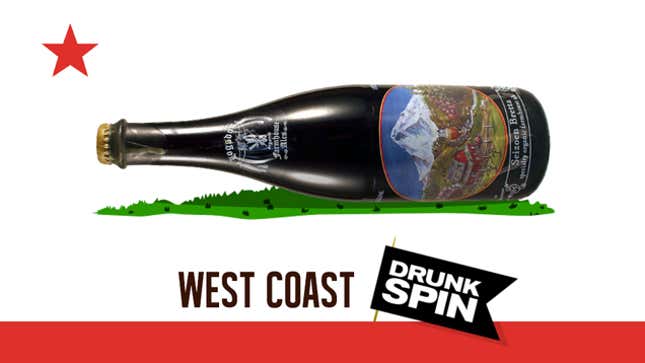
Dear Drunkspin,
I write you from the small mountain town of Julian, Calif., where this morning a hard and unusual rain fell, blanketing the hillsides in fog. I am here with my wife and our 2-month-old son Ellis to visit family, though we showed up early to have some time alone. Last night I roasted a chicken and built a fire and showed Ellis the dance of the firelight. He seemed impressed. Today I will build another fire, and the three of us will stare at it until we reach our private clarity, then we will go back to sleep.
In moments like these my thoughts are often given to beer. Not to drinking it, per se, but to the feeling of remove it gives me. A glass of beer is a passport to a certain kind of death. On dying this death you wake up in a diorama of the world in which everyone is friendly and nobody has a job. It is the same way with a good movie or book, or any experience that exists within life and yet delivers us from that life for a little while. Me, I like my diorama domestic and yet difficult to grasp, like a dream where you live in a house you’ve never seen but still know where the kitchen is.
At least part of this experience lies in the imagination. As a child in Ed Koch’s Manhattan, I often walked past the windows of the F.A.O. Schwarz dreaming of toys my parents never bought me, constructing the adventures we’d go on, the fun we’d have. So it is now, in the aisles of the beer store, staring at bottle labels and spiraling into minor fantasies about the worlds they construct, the people who dwell there, the drunk they get, the toys they no longer dream about. A good beer label doesn’t just tell you what’s in the bottle. A good beer label is a postcard from an imaginary place the beer will take you.
Some may call this soft science, marketing, voodoo. I’d invite those people to ask themselves if they would’ve enjoyed their last good meal as much as they did had they eaten it in a windowless room decorated with snakes, or while listening to the Doors. Branding is more powerful than all of us. Even my friend Lewis, an Iowan goliath who drinks Keystone by the case and doesn’t have much use for interesting beer even when he ends up liking interesting beer, is beholden to the power of image. The bland technocracy presented by the Keystone can suits him: It’s the drinker he wants to be, and hence the drinker he is.
Which brings me to two beers from a brewery in Hood River, Ore., called Logsdon: a saison and a saison brett, which go by the somewhat baroque names of Seizoen and Seizoen Bretta. The names alone suggest an older English, uncannily familiar and yet something we would not know how to respond to were someone to address us in it at the Safeway.
In my experience, saisons are complex and easily corrupted beers. A mediocre stout or IPA will usually be mediocre in one way; a mediocre saison can become an omnidirectional mistake. (The more there is to be done, the more there is to do wrong.) In general I like a good saison because they’re dry and fruity and yet have muscle to them. Because they are middleweight in stature, springy and amicable yet complex. A good saison will not go down easy, but will not seem hard once it’s gone.
If you have bothered to read this far, you may already know that saisons are also called farmhouse beers, which I mentioned because Logsdon brews theirs in a red clapboard farmhouse. As a modern person, I put no particular stock in this face, but the image holds romance nevertheless. After all, it’s the red clapboard Logsdon farmhouse that drew me to the beer in the first place.
I was sitting with my wife at a crowded bar in San Francisco, between two sets of young men in fleece zip-ups discussing their salaries. The music was bumping. Outside the window, people were playing craps against a brick wall. It had been a long day in a city I neither love nor understand. The red clapboard farmhouse on the Logsdon label called to me. Notice how it is green. Notice how it is quiet. Notice how there are no people in it.
This was the brett version, which I think is more worth the cost and headspace than the regular version. (At $12 for a 750ml bottle, neither are cheap, though I suppose $12 is about standard for a saison brett.) I have followed it on several occasions, in bottle and on draught. It is a cloudy, gold-colored beer, which further supports my layman’s fantasy that each glass contains a small square of pasture. Though a little on the sweet side, it has a dry, unsentimental finish. Some pours have reminded me faintly of apple juice, which as I understand it is a function of age and brett.
This is a fine beer that wipes its feet when it enters and leaves without saying goodbye. I like it and will drink it again. It is my Julian when Julian is too long a drive.
Mike Powell (@sternlunch) is a writer living in Tucson, Ariz.
Art by Sam Woolley.